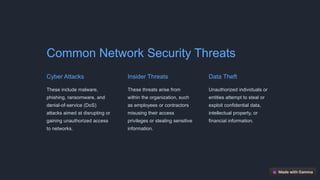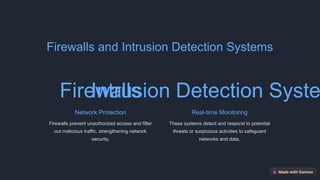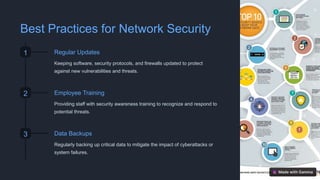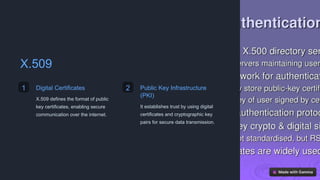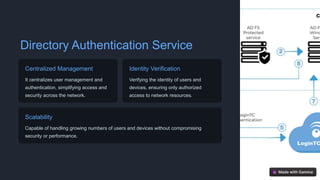Introduction-to-Computer Network-Security.pptx
- 1. Introduction to Network Security Network security is the practice of protecting computer networks and their data from unauthorized access, misuse, or modification. It includes both hardware and software technologies to ensure the security and integrity of data transmitted over a network. by Sumit Kumar
- 2. Importance of Network Security 1 Data Protection Network security is crucial for safeguarding sensitive information, preventing data breaches, and protecting end-users' privacy. 2 Business Continuity It ensures uninterrupted operations by defending against potential cyber threats and minimizing the risk of downtime. 3 Compliance and Legal Requirements Network security helps organizations meet legal mandates and industry regulations, avoiding penalties and legal consequences. 4 Reputation and Trust By maintaining a secure network, organizations build trust with customers, partners, and stakeholders, enhancing their reputation.
- 3. Common Network Security Threats Cyber Attacks These include malware, phishing, ransomware, and denial-of-service (DoS) attacks aimed at disrupting or gaining unauthorized access to networks. Insider Threats These threats arise from within the organization, such as employees or contractors misusing their access privileges or stealing sensitive information. Data Theft Unauthorized individuals or entities attempt to steal or exploit confidential data, intellectual property, or financial information.
- 4. Types of Network Security Measures 1 Access Control Restricting unauthorized users from accessing specific parts of the network, systems, or data. 2 Behavioral Analytics Using machine learning to detect abnormal network behavior and potential threats in real-time. 3 Vulnerability Management Identifying, classifying, and mitigating vulnerabilities to ensure network security.
- 5. Firewalls and Intrusion Detection Systems Firewalls Network Protection Firewalls prevent unauthorized access and filter out malicious traffic, strengthening network security. Intrusion Detection Syste Real-time Monitoring These systems detect and respond to potential threats or suspicious activities to safeguard networks and data.
- 6. Encryption and Authentication Methods Encryption Transforming data into an unreadable format to protect against unauthorized access. Two-Factor Authentication Enhancing security by requiring two forms of identification before granting access.
- 7. Best Practices for Network Security 1 Regular Updates Keeping software, security protocols, and firewalls updated to protect against new vulnerabilities and threats. 2 Employee Training Providing staff with security awareness training to recognize and respond to potential threats. 3 Data Backups Regularly backing up critical data to mitigate the impact of cyberattacks or system failures.
- 8. Kerberos Authentication Protocol Kerberos is a network authentication protocol that provides strong authentication for client/server applications. Single Sign-On (SSO) It allows users to access multiple applications with a single login, reducing the number of passwords they need to remember.
- 9. X.509 1 Digital Certificates X.509 defines the format of public key certificates, enabling secure communication over the internet. 2 Public Key Infrastructure (PKI) It establishes trust by using digital certificates and cryptographic key pairs for secure data transmission.
- 10. Directory Authentication Service Centralized Management It centralizes user management and authentication, simplifying access and security across the network. Identity Verification Verifying the identity of users and devices, ensuring only authorized access to network resources. Scalability Capable of handling growing numbers of users and devices without compromising security or performance.


